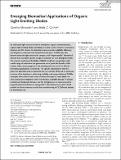Files in this item
Emerging biomedical applications of organic light-emitting diodes
Item metadata
| dc.contributor.author | Murawski, Caroline | |
| dc.contributor.author | Gather, Malte Christian | |
| dc.date.accessioned | 2021-05-17T14:30:11Z | |
| dc.date.available | 2021-05-17T14:30:11Z | |
| dc.date.issued | 2021-07-10 | |
| dc.identifier | 273341569 | |
| dc.identifier | 842b20ed-f107-4a9d-8112-7d1beae054ae | |
| dc.identifier | 85105773520 | |
| dc.identifier | 000651132500001 | |
| dc.identifier.citation | Murawski , C & Gather , M C 2021 , ' Emerging biomedical applications of organic light-emitting diodes ' , Advanced Optical Materials , vol. 9 , no. 14 , 2100269 . https://doi.org/10.1002/adom.202100269 | en |
| dc.identifier.issn | 2195-1071 | |
| dc.identifier.other | ORCID: /0000-0002-4857-5562/work/94291645 | |
| dc.identifier.uri | https://hdl.handle.net/10023/23205 | |
| dc.description | Funding: Leverhulme Trust (Grant Number(s): RPG-2017-231); Alexander von Humboldt-Stiftung; Engineering and Physical Sciences Research Council (Grant Number(s): EP/R010595/1); Division of Chemical, Bioengineering, Environmental, and Transport Systems (Grant Number(s): 1706207) | en |
| dc.description.abstract | As solid‐state light sources based on amorphous organic semiconductors, organic light‐emitting diodes (OLEDs) are widely used in modern smartphone displays and TVs. Due to the dramatic improvements in stability, efficiency, and brightness achieved over the last three decades, OLEDs have also become attractive light sources for compact and “imperceptible” biomedical devices that use light to probe, image, manipulate, or treat biological matter. The inherent mechanical flexibility of OLEDs and their compatibility with a wide range of substrates and geometries are of particular benefit in this context. Here, recent progress in the development and use of OLEDs for biomedical applications is reviewed. The specific requirements that this poses are described and compared to the current state of the art, in particular in terms of the brightness, patterning, stability, and encapsulation of OLEDs. Examples from several main areas are then discussed in some detail: on‐chip sensing and integration with microfluidics, wearable devices for optical monitoring, therapeutic devices, and the emerging use in neuroscience for targeted photostimulation via optogenetics. The review closes with a brief outlook on future avenues to scale the manufacturing of OLED‐based devices for biomedical use. | |
| dc.format.extent | 22 | |
| dc.format.extent | 4260423 | |
| dc.language.iso | eng | |
| dc.relation.ispartof | Advanced Optical Materials | en |
| dc.subject | Biointegrated electronics | en |
| dc.subject | Biophotonics | en |
| dc.subject | Organic LEDs | en |
| dc.subject | Photomedicine | en |
| dc.subject | Transient electronics | en |
| dc.subject | QC Physics | en |
| dc.subject | QH301 Biology | en |
| dc.subject | TK Electrical engineering. Electronics Nuclear engineering | en |
| dc.subject | T-NDAS | en |
| dc.subject.lcc | QC | en |
| dc.subject.lcc | QH301 | en |
| dc.subject.lcc | TK | en |
| dc.title | Emerging biomedical applications of organic light-emitting diodes | en |
| dc.type | Journal article | en |
| dc.contributor.institution | University of St Andrews. Sir James Mackenzie Institute for Early Diagnosis | en |
| dc.contributor.institution | University of St Andrews. Centre for Biophotonics | en |
| dc.contributor.institution | University of St Andrews. Biomedical Sciences Research Complex | en |
| dc.contributor.institution | University of St Andrews. School of Physics and Astronomy | en |
| dc.identifier.doi | 10.1002/adom.202100269 | |
| dc.description.status | Peer reviewed | en |
| dc.identifier.url | https://onlinelibrary.wiley.com/toc/21951071/2021/9/14 | en |
This item appears in the following Collection(s)
Items in the St Andrews Research Repository are protected by copyright, with all rights reserved, unless otherwise indicated.

